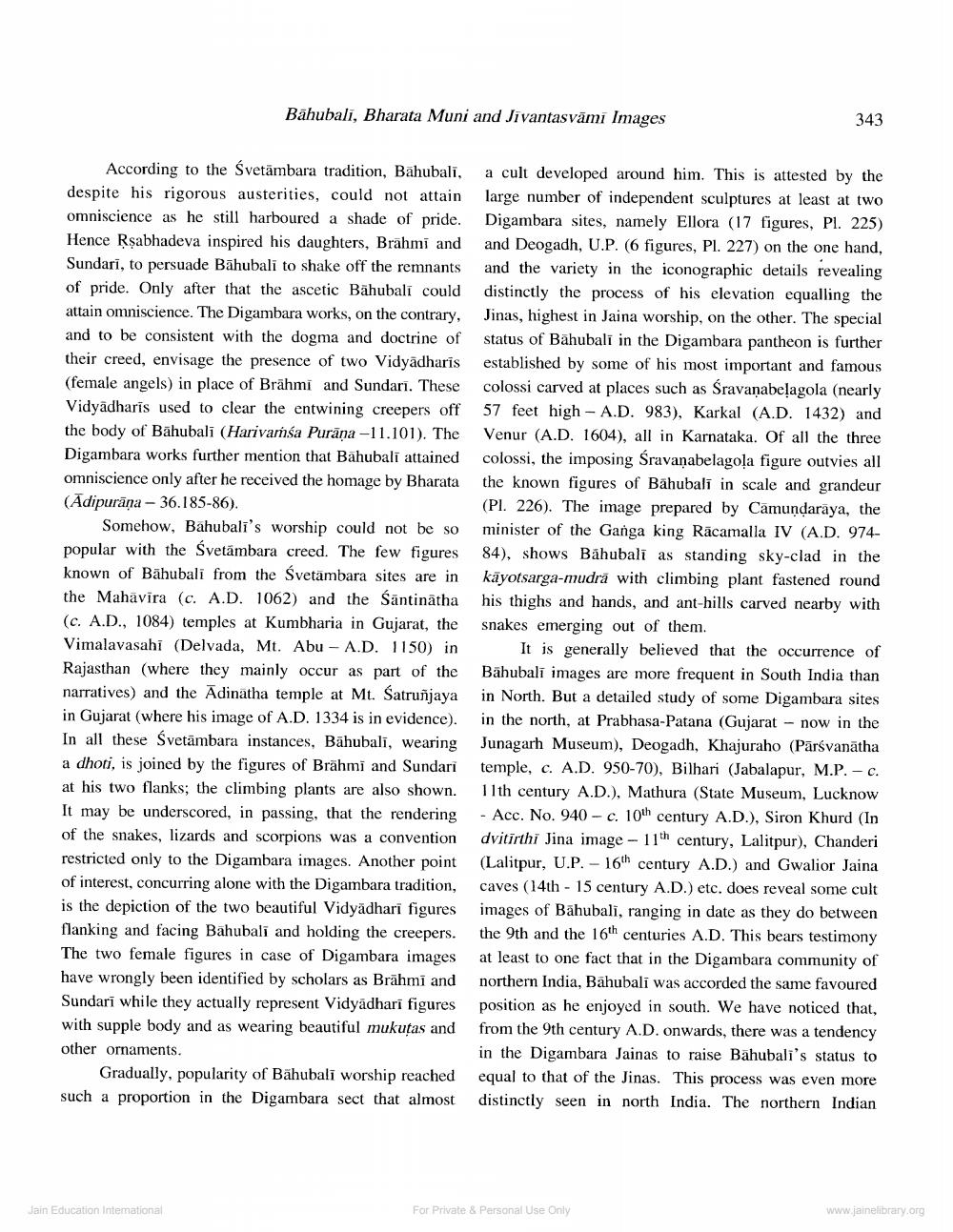________________
Bahubali, Bharata Muni and Jivantasvāmi Images
343
According to the Svetāmbara tradition, Bahubali, despite his rigorous austerities, could not attain omniscience as he still harboured a shade of pride. Hence Rşabhadeva inspired his daughters, Brahmi and Sundari, to persuade Bāhubali to shake off the remnants of pride. Only after that the ascetic Bāhubali could attain omniscience. The Digambara works, on the contrary, and to be consistent with the dogma and doctrine of their creed, envisage the presence of two Vidyadharis (female angels) in place of Brāhmi and Sundari. These Vidyadharis used to clear the entwining creepers off the body of Bāhubali (Harivaṁsa Purāņa -11.101). The Digambara works further mention that Bāhubali attained omniscience only after he received the homage by Bharata (Adipurāņa - 36.185-86).
Somehow, Bahubali's worship could not be so popular with the Svetämbara creed. The few figures known of Bāhubali from the Svetämbara sites are in the Mahavira (c. A.D. 1062) and the Säntinātha (c. A.D., 1084) temples at Kumbharia in Gujarat, the Vimalavasahi (Delvada, Mt. Abu - A.D. 1150) in Rajasthan (where they mainly occur as part of the narratives) and the Adinatha temple at Mt. Satrunjaya in Gujarat (where his image of A.D. 1334 is in evidence). In all these Svetāmbara instances, Bāhubali, wearing a dhoti, is joined by the figures of Brähmi and Sundari at his two flanks; the climbing plants are also shown. It may be underscored, in passing, that the rendering of the snakes, lizards and scorpions was a convention restricted only to the Digambara images. Another point of interest, concurring alone with the Digambara tradition, is the depiction of the two beautiful Vidyadhari figures flanking and facing Bahubali and holding the creepers. The two female figures in case of Digambara images have wrongly been identified by scholars as Brähmi and Sundari while they actually represent Vidyadhari figures with supple body and as wearing beautiful mukutas and other ornaments.
Gradually, popularity of Bahubali worship reached such a proportion in the Digambara sect that almost
a cult developed around him. This is attested by the large number of independent sculptures at least at two Digambara sites, namely Ellora (17 figures, Pl. 225) and Deogadh, U.P. (6 figures, Pl. 227) on the one hand, and the variety in the iconographic details revealing distinctly the process of his elevation equalling the Jinas, highest in Jaina worship, on the other. The special status of Bahubali in the Digambara pantheon is further established by some of his most important and famous colossi carved at places such as Sravanabelagola (nearly 57 feet high- A.D. 983), Karkal (A.D. 1432) and Venur (A.D. 1604), all in Karnataka. Of all the three colossi, the imposing Śravanabelagola figure outvies all the known figures of Bahubali in scale and grandeur (Pl. 226). The image prepared by Camundaraya, the minister of the Ganga king Rācamalla IV (A.D. 97484), shows Bāhubali as standing sky-clad in the kāyotsarga-mudra with climbing plant fastened round his thighs and hands, and ant-hills carved nearby with snakes emerging out of them.
It is generally believed that the occurrence of Bahubali images are more frequent in South India than in North. But a detailed study of some Digambara sites in the north, at Prabhasa-Patana (Gujarat - now in the Junagarh Museum), Deogadh, Khajuraho (Pārsvanātha temple, c. A.D. 950-70), Bilhari (Jabalapur, M.P. -c. 11th century A.D.), Mathura (State Museum, Lucknow - Acc. No. 940 - c. 10th century A.D.), Siron Khurd (In dvitithi Jina image - 11th century, Lalitpur), Chanderi (Lalitpur, U.P. - 16th century A.D.) and Gwalior Jaina caves (14th - 15 century A.D.) etc. does reveal some cult images of Bahubali, ranging in date as they do between the 9th and the 16th centuries A.D. This bears testimony at least to one fact that in the Digambara community of northern India, Bahubali was accorded the same favoured position as he enjoyed in south. We have noticed that, from the 9th century A.D. onwards, there was a tendency in the Digambara Jainas to raise Bahubali's status to equal to that of the Jinas. This process was even more distinctly seen in north India. The northern Indian
Jain Education Intemational
For Private & Personal Use Only
Jain Education International
For Private & Personal Use Only
www.jainelibrary.org




